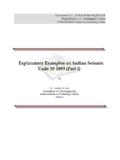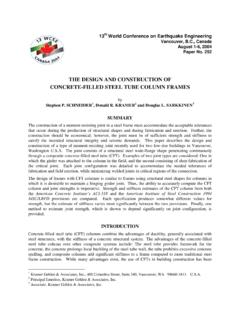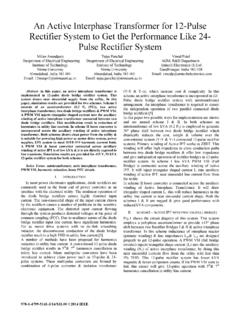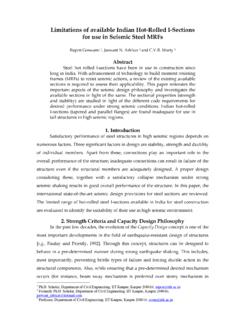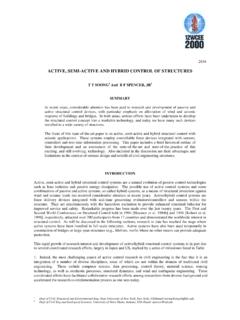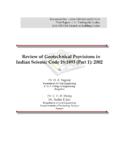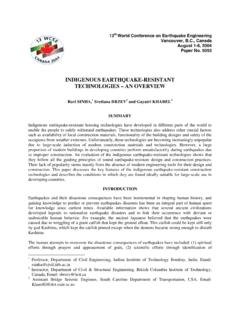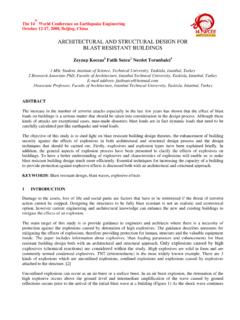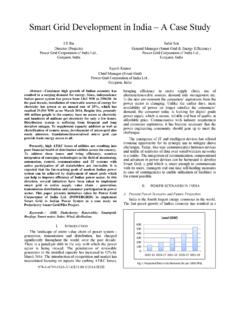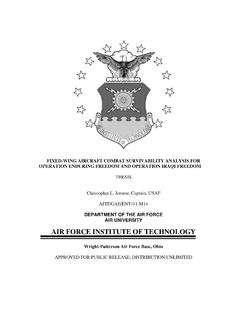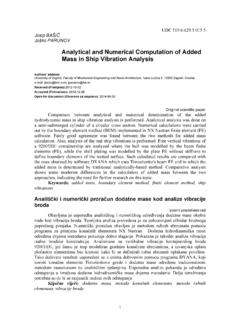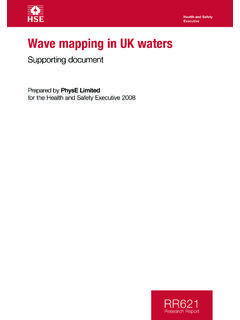Transcription of Review of Code Provisions on Seismic Analysis of …
1 Document No. :: Final Report :: A - Earthquake Codes IITK-GSDMA Project on Building Codes Review of code Provisions on Seismic Analysis of liquid storage Tanks by Dr. O. R. Jaiswal Department of Applied Mechanics Visvesvaraya National Institute of Technology Nagpur Dr. Durgesh C Rai Dr. Sudhir K Jain Department of Civil Engineering Indian Institute of Technology Kanpur Kanpur Review of Seismic Analysis of liquid storage Tanks Review of code Provisions on Seismic Analysis of liquid storage Tanks Abstract In the first part of this paper (Jaiswal, et. al., 2003), Provisions from various international codes on design Seismic forces for liquid storage tanks were reviewed. This paper reviews Provisions related with the Analysis and modeling aspects. These aspects include mechanical analogue of tank, time period of lateral and vertical mode of vibration, hydrodynamic pressure distribution, sloshing wave height, soil-structure interaction etc.
2 The codes reviewed are: ACI , AWWA standards, API 650, NZSEE. guidelines and Eurocode 8. It is noted that all the codes use mechanical analogues to evaluate hydrodynamic forces, particularly due to lateral base excitation. The Provisions on inclusion of effect of vertical excitation are not covered in all codes. Provisions of soil-structure interaction, buried tanks, flexibility of piping are either not addressed or are given in only qualitative terms. A brief description on limitations in Indian code is also presented. 1. INTRODUCTION. In the first part of this paper (Jaiswal et. al., 2003) Provisions on design Seismic forces for liquid storage tanks from various international codes were reviewed. In this paper, Provisions related with the Analysis and modeling of tanks are being considered. Seismic Analysis of liquid storage tanks requires special considerations.
3 These special considerations account for the hydrodynamic forces exerted by the fluid on tank wall. Knowledge of these hydrodynamic forces is essential in the Seismic design of tanks. Evaluation of hydrodynamic forces requires suitable modeling and dynamic Analysis of tank- liquid system, which is rather complex. However, availability of mechanical models (analogues) of tanks has considerably simplified the Analysis . These mechanical models, convert the tank- liquid system into an equivalent spring- mass system. Design codes use these mechanical models to evaluate Seismic response of tanks. While using such an approach, various other parameters also get associated with the Analysis . Some of these parameters are: Pressure distribution on tank wall due to lateral and vertical base excitation, time period of tank in lateral and vertical mode, effect of soil-structure interaction and 2.
4 Review of Seismic Analysis of liquid storage Tanks maximum sloshing wave height. Design Codes have Provisions with varying degree of details to suitably evaluate these parameters. In this paper, Provisions given in various codes on Seismic Analysis of tanks are reviewed. Codes considered are: ACI , AWWA D-100, AWWA. D-110, API 650, Eurocode 8 and NZSEE guidelines. The Review will in particular focus on following aspects: i) Mechanical model and its parameters ii) Hydrodynamic pressure due to lateral and vertical excitation iii) Time period of tank in lateral and vertical mode iv) Effect of soil flexibility 2. Review OF CODAL Provisions . Provisions given in ACI , AWWA D-100, AWWA D-110, API 650, Eurocode 8 and NZSEE guidelines will be reviewed. It may be noted that some of these codes deal with only specific types of tanks. Table 1 provides details of types of tanks considered in each of these codes.
5 It is seen that ground supported tanks are either fixed at base or rest on flexible base. The type of flexible base used and its description varies from code to code . Mechanical models As explained earlier, a mechanical model replaces the tank- liquid system by a spring-mass system, which considerably simplifies the evaluation of hydrodynamic forces. In these mechanical models it is recognized that vibrating fluid inside the container has two components, one that moves in unison with the tank (called impulsive component) and another one which undergoes sloshing motion (called convective component). Figure 1. schematically demonstrates such a mechanical model. Various quantities associated with a mechanical model are: impulsive mass (Mi), convective mass (Mc), height of impulsive mass (hi), height of convective mass (hc) and convective mode time period (Tc).
6 It may be noted that heights hi and hc are used when base pressure is not considered. If base pressure is included then corresponding heights are denoted by h'i and h'c respectively. 3. Review of Seismic Analysis of liquid storage Tanks Historically, mechanical models were first developed for tanks with rigid walls. Housner (1963) was perhaps the first to propose such a mechanical model for circular and rectangular rigid tanks (Figure 1). Wozniak and Mitchell (1978) have generalized the Housner's model for short and slender tanks. Veletsos and Yang (1977) have used a different approach to arrive at a similar type of mechanical model for circular rigid tanks. Subsequently, Haroun and Housner (1981) and Veletsos (1984) have developed mechanical models for flexible tanks. Malhotra et. al. (2000) have further simplified the flexible tank model of Veletsos (1984).
7 In Figure 3a to 3d a comparison of various parameters of rigid and flexible tank models is shown. In these figures, results obtained from Wozniak and Mitchell (1978) and Veletsos and Yang (1977) ( rigid tank models) are plotted along with those of Malhotra et. al. (2000) ( flexible tank model). It is seen that there is no significant difference in the results obtained from rigid and flexible tank models. Veletsos (1984) has also made similar observation while comparing the rigid and flexible tank models. Various codes use one or the other mechanical models described above. ACI , AWWA D-100, AWWA D-110 and API 650 use mechanical model of Housner (1963) with modifications of Wozniak and Mitchell (1978). AWWA D- 100 and API 650 deal with circular steel tanks, which are flexible tanks. However, since there is no appreciable difference in the parameters of mechanical models of rigid and flexible tank models, these codes evaluate parameters of impulsive and convective modes from rigid tank models.
8 ACI. also mentions parameters of mechanical model for rectangular tanks. NZSEE guidelines (Priestley et. al. (1986)) use mechanical model of Veletsos and Yang (1977) for rigid circular tanks and that of Haroun and Housner (1981) for flexible tanks. For rigid rectangular tanks, it suggests use of rigid circular tank model wherein, radius is replaced by half length of tank. It states that in most cases, such an approximation for rectangular tanks is expected to give base shears within 15% of values from more exact theory. For flexible rectangular tanks, it suggests the same procedure as that of rigid rectangular tanks. This document also suggests procedure for evaluating 4. Review of Seismic Analysis of liquid storage Tanks impulsive and mechanical mass of horizontal circular cylindrical tanks, which is based on work of Wrner and Sundquist (1949).
9 Eurocode 8 mentions mechanical model of Veletsos and Yang (1977) as an acceptable procedure for rigid circular tanks. For flexible circular tanks, models of Veletsos (1984) and Haroun and Housner (1981) are described along with the procedure of Malhotra et. al. (2000). For rigid rectangular tanks it suggests model of Housner (1963). The procedure given in NZSEE guidelines is also described in Eurocode 8 for evaluating impulsive and convective mass of horizontal circular tank. An important point while using a mechanical model pertains to combination rule used for adding the impulsive and convective forces. Except Eurocode 8, all the codes suggest SRSS (square root of sum of square) rule to combine impulsive and convective forces. Eurocode 8 suggests use of absolute summation rule. For evaluating the impulsive force, mass of tank wall and roof is also considered along with impulsive fluid mass.
10 ACI and Eurocode 8. suggest a reduction factor to suitably reduce the mass of tank wall. Such a reduction factor was suggested by Veletsos (1984) to compensate the conservativeness in the evaluation of impulsive force. Time period of impulsive mode Impulsive mode refers to lateral mode of tank- liquid system. Lateral Seismic force on tank depends on the impulsive mode time period. Time period of tank-fluid system depends on the flexibility of support also. Table 2 gives details of the expressions used in various codes to evaluate the impulsive mode time period. For fixed base circular tanks, ACI uses formula given by Veletsos (1984), whereas NZSEE guidelines have adopted the formula from Haroun and Housner (1981). Eurocode 8 has followed the expression given by Sakai et. al. (1984). Eurocode 8 also gives the expression suggested by Malhotra et.
